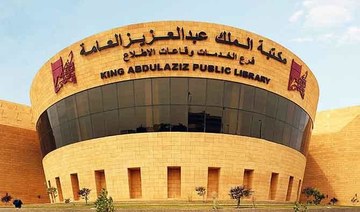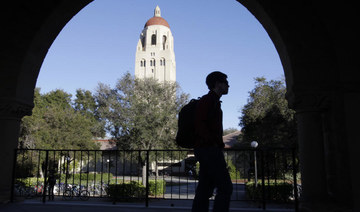WASHINGTON: President Donald Trump turned up the pressure on China on Sunday, threatening to hike tariffs on $200 billion worth of Chinese goods.
Trump’s comments, delivered on Twitter, came as a Chinese delegation was scheduled to resume talks in Washington on Wednesday aimed at resolving a trade war that has shaken financial markets and cast gloom over the world economy.
Trump turned up the heat by saying he would raise import taxes on $200 billion in Chinese products to 25% from 10% on Friday.
The Wall Street Journal, citing unidentified sources, said China’s government was considering canceling this week’s talks. Beijing has responded to previous US threats by saying it wouldn’t negotiate under pressure.
Stock markets fell on the news. The future for the Dow Jones Industrial Average lost 1.5 percent while Tokyo’s Nikkei 225 retreated 0.2 percent.
Trump had twice pushed back deadlines — in January and March — to raise the tariffs in a bid to buy more time for a negotiated settlement. But on Sunday, Trump, who has called himself a “tariff man,” said he’s losing patience. “The Trade Deal with China continues, but too slowly, as they attempt to renegotiate. No!” Trump tweeted.
In his tweets, Trump also threatened to slap tariffs on another $325 billion in Chinese imports, covering everything China ships annually to the United States.
The two countries are locked in a high-stakes dispute over China’s push to establish itself as a technological super power. The US charges that China is resorting to predatory tactics — including cybertheft and forcing foreign companies to hand over technology — in a drive to establish Chinese companies as world leaders in advanced industries such as robotics and electric vehicles.
The administration has repeatedly suggested that the negotiators are making progress. A month ago, Trump said that the two countries were “rounding the turn” and predicted that “something monumental” would be achieved in the next few weeks.
But last week, Treasury Secretary Steven Mnuchin seemed to temper expectations, suggesting that Washington was willing to “move on” if it can’t get the deal it wants.
A substantive deal would require China to rethink the way it pursues its economic ambitions, abandoning or scaling back subsidies to its companies, easing up on the pressure for foreign companies to share trade secrets, and giving them more access to the Chinese market.
Philip Levy, senior fellow at the Chicago Council on Global Affairs and a White House economist under President George W. Bush, said the talks are too complicated for Trump’s high-pressure tactics to work. “The president treats this like we’re haggling over the price of a used car,” Levy said.
Trump has made a priority of shaking up American trade policy.
As a candidate for the presidency, Trump raged repeatedly about alleged Chinese perfidy — so much so that a video mashup of him spitting out the word “China” went viral and collected more than 15 million views on Youtube.com.
Trump charged that previous administrations, gullible and weak, had let China get away with abusive trade practices, accepting empty promises from Beijing and allowing the US-China economic relationship to grow ever more lopsided. As evidence, he pointed to America’s vast US trade deficit with China — $379 billion last year, by far the biggest with any country in the world.
Once he took office, Trump’s relationship with his Chinese counterpart, Xi Jinping, seemed to get off to a good start. The two men shared chocolate cake and amiable conversation at Trump’s resort in Mar-a-Lago, Florida, in April 2017. A few weeks later, China agreed to open its market US beef, cooked chicken, and natural gas in what Commerce Secretary Wilbur Ross called a “herculean accomplishment.”
The romance faded. In March 2018, the Office of the US Trade Representative issued a report accusing China of using predatory tactics to strengthen its tech companies.
Last July, the Trump administration gradually began slapping import taxes on Chinese goods to pressure Beijing into changing its policies. It now has imposed 10% tariffs on $200 billion in Chinese imports and 25% tariffs on another $50 billion. The Chinese have retaliated by targeting $110 billion in US imports.
The fight between the world’s two biggest economies is raising worries about global economic growth. The International Monetary Fund, the World Bank, and others have downgraded their forecasts for the world economy, saying the US-China standoff is reducing world trade and creating uncertainty for companies trying to decide where to buy supplies, build factories, and make investments.
Trump has portrayed his tariffs as a moneymaker for the United States and a benefit to the US economy.
But a March study by economists from the Federal Reserve Bank of New York, Columbia University, and Princeton University found that the burden of Trump’s tariffs — including taxes on steel, aluminum, solar panels, and Chinese imports — falls entirely on US consumers and businesses who buy imported products. By the end of last year, the study found, they were paying $3 billion a month in higher taxes and absorbing $1.4 billion a month in lost efficiency.
Nonetheless, the overall US economy has remained healthy. On Friday, the government reported that the US unemployment rate had fallen to the lowest level in half a century.
The prospect of higher tariffs and heightened tensions could alarm investors when markets open Monday. “When the president puts his foot down, it makes the market go down,” Chris Rupkey, chief financial economist at MUFG Union Bank, wrote in a research note Sunday. “Tariff man is back just in time to make the stock market dive, dive, dive.”
Trump threatens to hike tariffs on $200B of Chinese imports
Trump threatens to hike tariffs on $200B of Chinese imports

- Last July, the Trump administration gradually began slapping import taxes on Chinese goods to pressure Beijing into changing its policies
Saudi energy minister lauds growing economic ties with Uzbekistan
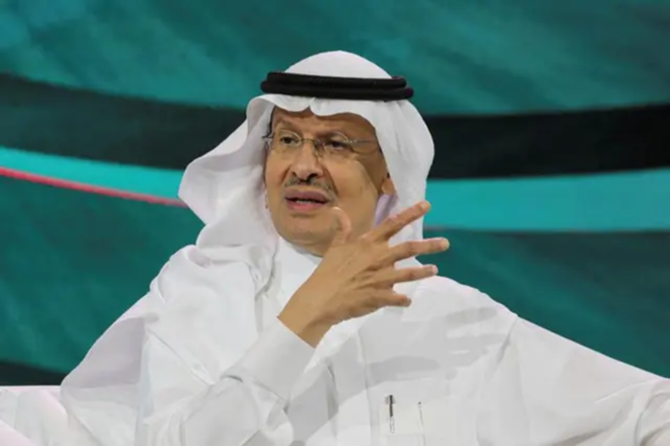
RIYADH: Saudi Arabia and Uzbekistan’s economic cooperation models reflect mutual commitment to prosperity through shared goals in the two countries’ 2030 plans, said the Saudi energy minister.
During the main dialogue session of the third Tashkent International Investment Forum, Prince Abdulaziz bin Salman emphasized the distinguished relations between the two nations and the commitment of their leaderships to enhance and develop cooperation in all fields, particularly in the energy sector.
Uzbekistan President Shavkat Mirziyoyev also attended the meeting.
The Saudi minister pointed out that economic cooperation between the two countries serves as a model, especially in light of the “Uzbekistan 2030” strategy and the Kingdom’s Vision 2030, with their similar goals aimed at economic growth, diversification, and sustainable development, reflecting a mutual commitment to building a prosperous future for both nations, according to the Saudi Press Agency.
“The bilateral relations saw a notable advancement subsequent to a meeting between Crown Prince Mohammed bin Salman and President Mirziyoyev in Riyadh in 2022,” he said.
Prince Abdulaziz stressed the significance of the energy sector in the growing relations between the two nations, particularly in renewable energy, highlighting the substantial involvement of Saudi companies in Uzbekistan, exemplified by ACWA Power.
He elaborated on the investment flowing between the two countries in this domain, eclipsing $14 billion, with the aim of producing over 11 gigawatts of renewable energy electricity, affirming that Uzbekistan has demonstrated a serious commitment to achieving a fair and equitable energy transition, aligning with the Kingdom’s aspirations.
The energy minister further underscored the rational stances jointly embraced by both nations, placing significant emphasis on the critical aspects of energy security, development, and conservation.
He also underscored the two countries’ collaborative roles in addressing climate change through collective endeavors.
Recently, ACWA Power signed a power purchase agreement with the National Electric Grid of Uzbekistan for the Aral five-gigawatt wind power project worth SR18.2 billion ($4.85 billion).
Two weeks ago, ACWA Power announced it had secured an $80 million equity bridge loan from the Bank of China for its projects in Uzbekistan.
The Saudi entity said the fund will boost its Tashkent 200 megawatts solar photovoltaic power plant and 500 MW per hour battery energy storage system project in Uzbekistan.
“This transaction culminated the initial agreement reached during the 3rd BRF (Belt and Road Forum) summit in October 2023, where ACWA Power was represented by its chairman as a keynote speaker,” the company said in a statement.
Alvarez & Marsal opens regional headquarters in Riyadh
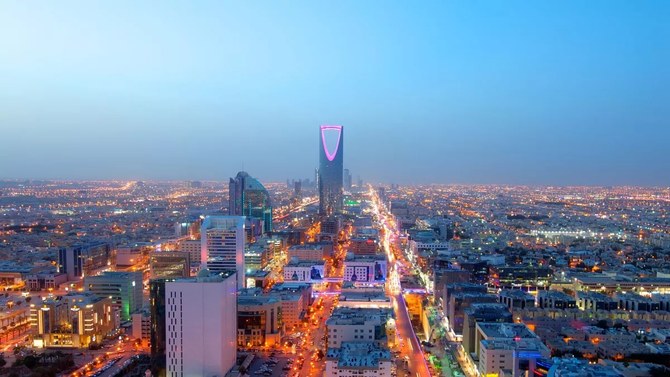
RIYADH: Underscoring international confidence in the Saudi economy, global consulting firm Alvarez & Marsal has become yet another company to have opened its regional headquarters in Riyadh.
In a press statement, the US firm stated that the inauguration of the new regional headquarters underscores its commitment to contributing to the country’s transformation agenda.
“As the company continues to deepen its roots in the country, with expertise across various sectors — from banking and tax to healthcare and disputes and investigations — this strategic move aims to leverage local insights in the Kingdom to drive sustainable growth and innovation.” the company said.
Additionally, A&M announced that it has included 13 skilled Saudi graduates in the inaugural batch of its Bidayah Graduate Program.
The company stated that these candidates were selected from a competitive pool of applicants, describing the chosen individuals as representing the bright future of the Kingdom and reflecting the potential that A&M sees in local talent.
James Dervin, managing director of A&M in the Middle East and co-head in the region, stated that the program is designed to develop the next generation of execution-focused leaders in management consulting. It is guided by the A&M principles of leadership, action, and results.
“Over the course of 12 months, participants will undergo rigorous training, engage in live project work, and receive mentorship from seasoned industry experts,” he said.
Dervin added: “Coupled with the incorporation of our regional headquarters in Saudi Arabia, the program underscores A&M’s commitment to investing in the professional development of Saudi nationals and aligning with the Kingdom’s ambitious Vision 2030,”
He further noted that the new graduates will have a significant, positive impact on his firm and the clients it serves.
Commenting on the close alignment of A&M’s global brand with the local market dynamic in Saudi Arabia, Bryan Marsal, A&M’s CEO and co-founder, said: “The all-encompassing nature of the Saudi Arabian transformation is driving significant demand for A&M’s distinctive ‘get-stuff-done’ brand of services — for our ability to fix problems, our ‘skin in the game’, and our freedom from audit conflicts.”
With over 9,000-strong workforce across six continents, A&M generates tangible results for corporations, boards, private equity firms, law firms, and government agencies grappling with intricate challenges, according to its website.
More than 180 major global companies and organizations have already established regional headquarters in the Saudi capital. These include Apple, Microsoft and Alibaba, as well as the IMF, IBM, and Google.
Other notable entities on the list include German consultancy firm TUV Rheinland, PwC Middle East, Aramex and Amazon.
UAE banks’ aggregate capital, reserves exceed $136bn
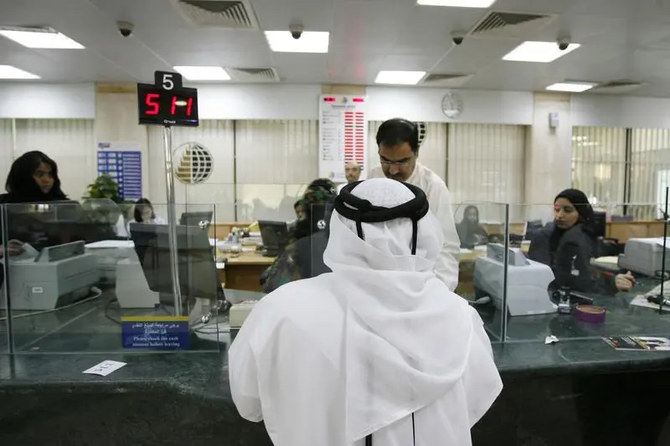
RIYADH: UAE-based banks’ aggregate capital and reserves reached 501.5 billion dirhams ($136 billion) at the end of February, up 14.4 percent year-on-year, according to new data.
The latest statistics from the Central Bank of the UAE showed that on a monthly basis, the total capital and reserves grew 0.95 percent, reflecting an increase of approximately 4.7 billion dirhams, according to the Emirates News Agency, also known as WAM.
This rise in figures falls in line with the central bank’s goal of enhancing monetary and financial stability in the country.
Moreover, the data indicated that national banks accounted for around 86.5 percent of the aggregate capital and reserves of banks operating in the UAE. At the end of February, they recorded a total of 433.7 billion dirhams, an annual rise of 14.6 percent.
On the other hand, the share of foreign banks settled at 13.5 percent, hitting 67.8 billion dirhams at the end of the same month, reflecting a 13.2 percent surge compared to the same period a year earlier.
Furthermore, at the end of February, the total capital and reserves of banks operating in Dubai alone stood at 246.4 billion dirhams, logging a year-on-year growth of 15.1 percent.
Additionally, banks operating in Abu Dhabi recorded around 217 billion dirhams, up 13 percent from the corresponding period in 2023.
Meanwhile, the cumulative capital and reserves of banks operating in other emirates combined reached an estimated 38.1 billion, reflecting a 15.5 percent climb in comparison to the same period a year prior.
In March, a top executive at Roland Berger said that UAE bank branches were witnessing the highest revenues in the region, amounting to $18.6 million per branch.
This was driven by the nation’s digital transformation, which enabled financial institutions in the Gulf Cooperation Council to reduce the number of banking branches by 328 within three years, Saumitra Sehgal, the global consulting firm’s head of financial services in the Middle East, told WAM, at the time.
Sehgal also pointed out at the time that the number of bank branches across GCC nations decreased from 4,067 at the end of 2019 to 3,739 by December 2022.
He further noted that banks in the UAE saw the highest number of outlets merge and reduce with the support of digital transformation between 2019 and 2022.
Saudi financial robo-advisory firm Abyan Capital secures $18m in funding
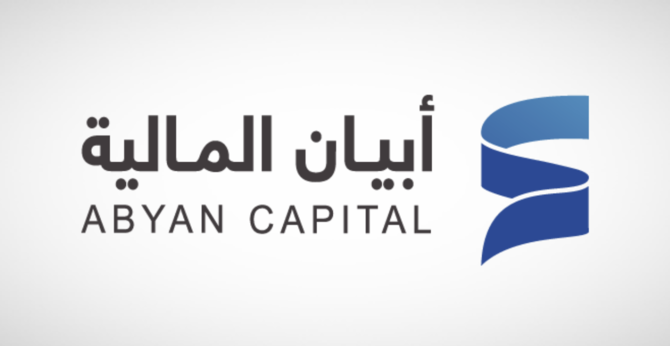
RIYADH: Financial robo-advisory firm Abyan Capital has secured $18 million in funding in further evidence of the growing confidence in the Kingdom’s artificial intelligence sector.
Led by STV, the funding round also saw participation from Aramco’s Wa’ed Ventures and RZM Investment.
Robo-advisors are digital platforms that utilize AI and machine learning algorithms to automate and optimize investment processes.
Founded in 2022 by Abdullah Al-Jeraiwi, Omar Al-Mania and Saleh Al-Aqeel, Abyan Capital is a financial services company that provides an automated solution and portfolio management for long-term investments.
“Abyan Capital stands out by unlocking the SR300 billion ($80 billion) investment management and wealth advisory sector for investors from all backgrounds in Saudi Arabia, through its mobile-first, robo-advisory model,” Yazeed Al-Turki, principal at STV, said in a statement.
In a short period of time, he said Abyan has enabled a large base of first-time investors to access multiple wealth management solutions, underscoring the team’s commitment to innovation and inclusivity.
“We are delighted to partner with Abdullah, Saleh and the team on their journey to redefine the wealth management ecosystem in the Kingdom,” Al-Turki added.
The company aims to utilize its newly secured funds to further enhance its platform, expand its suite of financial products, and accelerate its market penetration across the investment solution value chain.
“Today, we are proud that in a very short amount of time, Abyan has exceeded deposits of over SR1.4 billion and more than 100,000 portfolios invested. And we will be launching new diversified products soon with a goal to make Abyan the digital retail investment house,” said Al-Jeraiwi, the CEO.
Closing Bell: TASI ends the week in green at 12,352
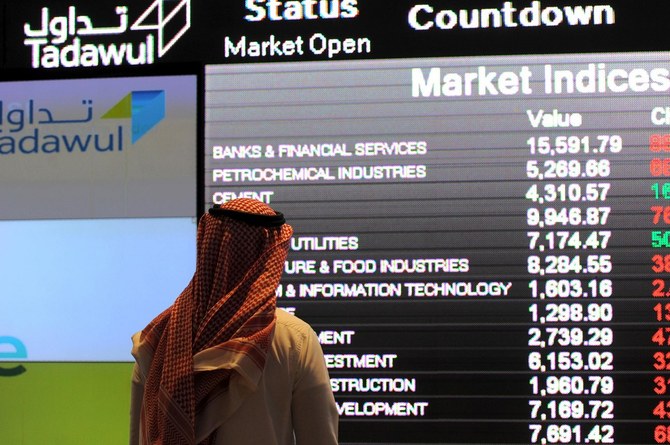
RIYADH: Saudi Arabia’s Tadawul All Share Index ended the week by gaining 6.68 points, or 0.05 percent, to close at 12,352.33 on Thursday.
The total trading turnover of the benchmark index was SR6.55 billion ($1.74 billion) as 120 stocks advanced, while 103 retreated.
The parallel market, Nomu, also gained 95.60 points, or 0.36 percent, to close the trading session at 26,457.81. This comes as 29 stocks advanced, while as many as 27 retreated.
On the other hand, the MSCI Tadawul Index slipped by 2.37 points, or 0.15 percent, to close at 1,547.20.
The best-performing stock on the benchmark index was Al-Baha Investment and Development Co., as its share price surged by 7.69 percent.
Other top performers included Raydan Food Co. and the Company for Cooperative Insurance, whose share prices soared by 7.29 percent and 6.63 percent, to stand at SR30.90 and SR160.80 respectively.
Electrical Industries Co. and the Mediterranean and Gulf Insurance and Reinsurance Co. also fared well during the last trading session of the week.
The worst performer was Saudi Chemical Co., whose share price dropped by 5.36 percent to SR7.77.
Power and Water Utility Co. for Jubail and Yanbu as well as the National Company for Glass Industries, underperformed as their share prices dropped by 5.22 percent and 4.82 percent to stand at SR63.50 and SR42.45, respectively.
On the announcements, Bank AlJazira announced its interim financial results for the period ending March 31 with net profit amounting to SR300.4 million compared to SR279.3 million in the previous quarter.
In an official statement on Tadawul, the bank attributed the increase in the net income to a decrease in total operating expenses by 6 percent.
“The decrease in total operating expenses is mainly due a decrease in net impairment charge for financing and other financial assets, other general and administrative expenses, salaries and employee-related expenses and other operating expenses against an increase in depreciation and amortization expenses,” the statement said.
Conversely, there has been a slight decrease of 0.2 percent in total operating income, primarily attributed to a reduction in net financing and investment gains. Additionally, the rise in net income was partially tempered by increased zakat charges over the period.



